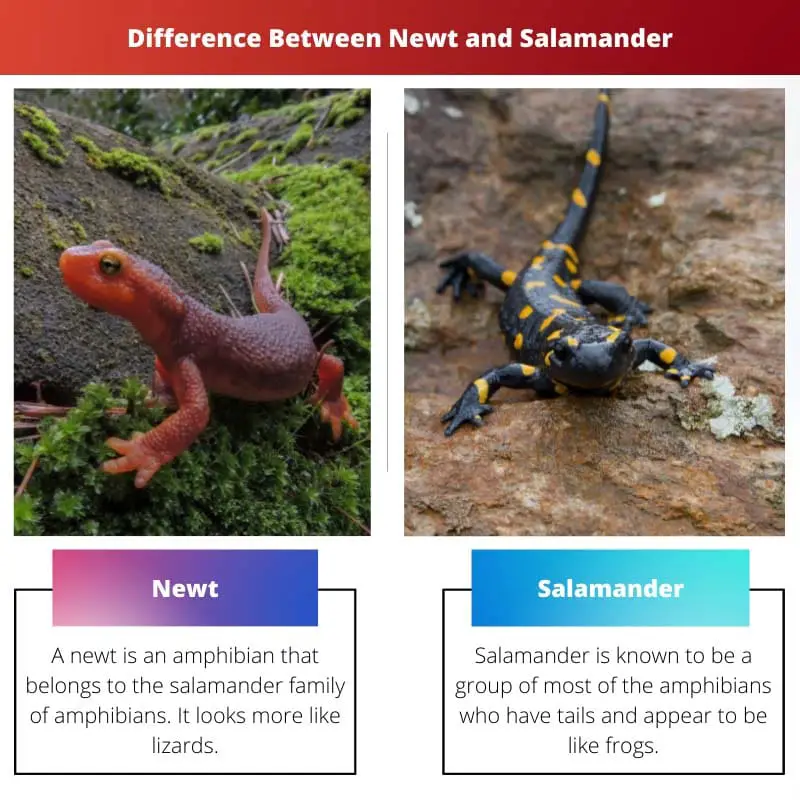Both newts and salamanders fall under the amphibian. Amphibian comprises two words: Amphi (dual) and bio (life), and it refers to animals that can live on land and underwater.
Though newt is one type of salamander, it is somewhat different from them. Furthermore, most amphibians with tails are classified as salamanders.
Key Takeaways
- Newts are a specific subgroup of salamanders, a larger amphibians group.
- Newts have rough, dry skin and spend more time on land than salamanders.
- Newts exhibit more complex courtship behaviors and reproductive strategies than other salamanders.
Newt vs Salamander
The difference between newts and salamanders is that newt amphibians are brighter in colour than salamanders due to toxins in their bodies. Moreover, the newt prefers to live alternatively as both land species and aquatic animals, while the salamander mostly lives underwater like other marine animals.

A newt is a salamander that differs from the other amphibians belonging to the salamander family in terms of physical appearance (coarse and bright in hue), habitat (semi-aquatic), and way of living.
The threat to their survival comes from human activities (loss of habitat and pollution). Otherwise, it has a life span of up to fourteen years.
The oldest fossils of the amphibian salamander may be in Kyrgyzstan. When physically touched, they resemble frogs and are wet. Generally, it can be found in the northern part of the hemisphere.
Human activities or predator invasion pose a threat to their survival. Therefore, in most countries, it is specially protected.
Comparison Table
| Parameters of Comparison | Newt | Salamander |
|---|---|---|
| Skin Texture | Newt has rough skin and looks very dry. | Salamander has smooth skin. |
| Physical Appearance | Defence mechanism | It has larger feet and tails comparatively. |
| Habitat | Live alternatively on land and in water. | It lives in a moist area (either near water bodies or underwater). |
| Breeding | Newt breed in the deep ponds. | Salamander either breed in water bodies or forests. |
| It leaves its tails behind like lizard as a defense mechanism against predators. | It secrets the poisonous toxins to attack the predators. | It leaves its tails behind like lizard as a defence mechanism against predators. |
What is Newt?
A newt is an amphibian that belongs to the salamander family of amphibians. It looks more like lizards. Despite being classified as a salamander, it is distinct from other members of the reptile family.
Newt was discovered for the first time during the late Mesozoic period when oceans were forming. A total of 100 new species have been identified, most of which are found in North America, Europe, North Africa, and Asia.
To protect themselves from predators, most newts are venomous and produce toxins. Furthermore, it contains tetrodotoxin (dangerous toxins for the human body if ingested). As a result, eating newts is not recommended.
The newt’s skin is tough and has webbed feet and tails like a rudder (beneficial for swimming). Newt comes in vibrant colours, including orange, olive, and brown.
For protection and hibernation during the winter, newts seek refuge in piles and muddy pond banks.
The female newt lays about 200 eggs on the leaves in the spring when it breeds in the water. The newt goes through three stages of development.
The first stage is aquatic larvae, which means they stay in the water for up to five months before moving on to the second stage, which is known as the terrestrial juvenile stage.
It means it lives on the land after five months in this stage and is called eft. When it becomes an adult, it enters an adult stage and then lives underwater. It means, while growing, newts live alternatively underwater and on land.
A unique feature of newts is their ability to repair body parts if predators damage or harm them. Even some newts can regenerate their iris.

What is Salamander?
Salamander is known to be a group of most of the amphibians who have tails and appear to be like frogs. Newt also falls under this group.
Since salamanders mostly live in moist places, their skin is damp when touched. They even lay their eggs in the wet (near water bodies).
Salamanders can grow in multiple ways depending on the species. For example, some thrive in water, like a newt. Some grow from an egg on land. There are a few which develop from the tiny larva.
The salamander could be six feet long or only 0.6 inches long (Thoriusarboreus salamander). It has long paws, a tail, and an entire body.
Furthermore, they look to be slim. They are primarily found in the Holarctic realm or ecozone.
Moreover, some have two legs, while others have four. But like all amphibians, they have four limbs and do not have claws like land animals.
They appear to be dull in hue. Since they are environmentally sensitive, they fall under endangered species in some regions like the USA.
They are nocturnal (very active at night and lazy in the morning). Underwater, they tend to breathe through either gills, lungs, or skin based on the different members of the salamander.

Main Differences Between Newt and Salamander
- Newt breeds in water during spring. However, salamanders can breed on land or in water, depending on the type of the species.
- The newt has four legs, while the salamander has two or four legs.
- The newt has a very rough skin texture in comparison to the salamander, which is glossy.
- The newt can regenerate most body’s organs, such as limbs and tails. On the other hand, most salamanders can only regenerate tails.
- The newt appears very vibrant as compared to other salamanders.
- The newt can defend itself by releasing extremely toxic toxins. On the contrary, salamander leaves their tails back to fool predators and save themselves.

- https://www.cambridge.org/core/journals/biological-reviews/article/evolutionary-ecology-of-facultative-paedomorphosis-in-newts-and-salamanders/45CD23C93EF284DC03576F7B9791B54A
- https://www.sciencedirect.com/science/article/pii/S0065345408602028

This is so interesting! I had no idea newts and salamanders were so similar and yet so different. These creatures are so fascinating.
Yes, it’s interesting how their behaviors and strategies set them apart. Great read!
I know, right? Their similarities and differences are quite intriguing. I am amazed by their distinct characteristics.
I found this article to be quite comprehensive and educational. Excellent job in providing detailed information and comparisons.
Indeed, the detailed comparison and information were quite enlightening. Great work!
Absolutely, I appreciate how thorough and informative it is. This post provided a comprehensive look at both creatures.
While I find the topic interesting, I didn’t feel that the article provided a comprehensive view of the differences between newts and salamanders.
This post was enlightening. I appreciate the author’s attention to detail and thorough coverage of the topic.
Absolutely, the author did an excellent job in providing a comprehensive understanding of newts and salamanders.
The article provided a deep insight into the unique aspects of newts and salamanders. Thoroughly enjoyed it!
This was a very insightful piece. I appreciate the in-depth look at newts and salamanders and their unique differences.
The article certainly offers valuable information. I’m impressed by its depth and insight.
Agreed, the detailed comparison presented in this article helps understand newts and salamanders much better.
This article was very informative. I now have a better understanding of the distinct characteristics and behaviors of newts and salamanders.